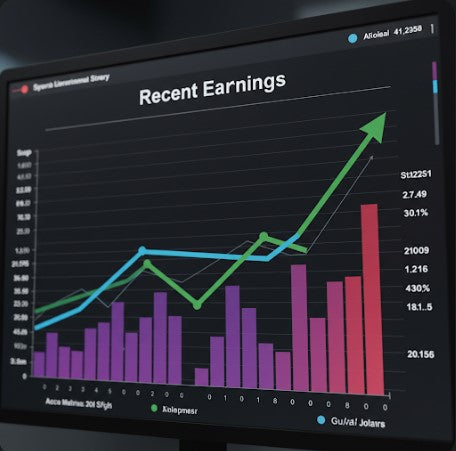
Corporate Earnings Resilience: What Recent Reports Tell Investors About Market Volatility
Share
Corporate Earnings Resilience: What Recent Reports Tell Investors About Market Volatility
Understanding the latest earnings season and why strategic investors might welcome market fluctuations
In recent weeks, we've witnessed an interesting earnings season with major companies reporting stronger-than-expected profits despite looming economic uncertainties. For savvy investors who understand position management systems like Micro-Rebalancing, these market dynamics offer valuable insights – and potentially profitable opportunities.
What the Latest Earnings Reports Are Telling Us
The S&P 500 recently climbed 0.6%, extending its winning streak to six consecutive days, while the Dow Jones Industrial Average added 300 points (0.7%) and the Nasdaq composite rose 0.5%. These gains were largely driven by companies exceeding analyst expectations in their quarterly reports.
Let's examine some notable performers:
Honeywell International: The Power of Strong Guidance
Honeywell's stock jumped 5.4% after not only beating profit and revenue expectations but also raising its full-year forecast. This highlights an important aspect of earnings reports that many investors overlook: forward guidance often impacts stock prices more than historical performance.
CEO Vimal Kapur's statement acknowledged "an uncertain global demand environment for the remainder of 2025," yet the company's confident outlook suggests operational resilience. This combination of strong current performance with cautious optimism presents exactly the kind of price movement patterns that systematic investors can capitalize on.
Sherwin-Williams: Supply Chain Resilience
Paint and coatings company Sherwin-Williams rose 4.8% following better-than-expected profits. CEO Heidi Petz noted that while customer softness might persist into the second half of the year, the company's localized supply chain could provide protection against tariff impacts.
This illustrates how company-specific factors can drive stock performance independently from broader market trends – a nuance that index ETF investors using systems like Micro-Rebalancing can benefit from through the natural volatility of ETFs like SPY stock and QQQ stock.
Mixed Signals: UPS and Others
Not all earnings stories were straightforward bullish signals. UPS reported stronger-than-expected profits but declined to update financial forecasts citing "current macro-economic uncertainty." The stock fluctuated before closing 0.4% lower, despite the earnings beat.
Similarly, General Motors slipped 0.6% despite exceeding profit expectations, as the company rescheduled its investor call amid trade policy uncertainties.
These mixed reactions demonstrate how earnings reports interact with broader economic concerns to create the market volatility that drives price movements in individual stocks and ETFs.
Understanding Earnings Reports: Beyond the Headlines
For investors to properly contextualize these results, it's important to understand what earnings reports actually tell us – and what they don't.
Key Components of Earnings Reports
- Revenue (Top Line): The total income generated before expenses
- Earnings (Bottom Line): Profits after subtracting all expenses
- Earnings Per Share (EPS): Profits divided by outstanding shares
- Forward Guidance: Management's expectations for future performance
- Key Performance Indicators (KPIs): Industry-specific metrics
The "Beat" vs. "Miss" Framework
When financial media report that a company "beat" or "missed" expectations, they're typically referring to analyst consensus estimates. These expectations are crucial because stock prices often reflect anticipated performance rather than past results.
A company that exceeds low expectations might see its stock rise even with objectively mediocre results. Conversely, a company with excellent results might see its stock fall if those results fall short of lofty expectations.
Reading Between the Lines: Management Commentary
Perhaps most valuable are the qualitative insights from management:
- Honeywell acknowledged uncertainty while expressing confidence in its operational capabilities
- Sherwin-Williams highlighted supply chain advantages that could mitigate external pressures
- UPS announced significant cost-cutting measures including 20,000 job cuts and closing 73 facilities
- Coca-Cola stated that tariff impacts would likely be "manageable" while maintaining key growth guidance
These narratives provide context that raw numbers cannot, helping investors understand how companies perceive their operational environment.
Market Uncertainty as an Investment Opportunity
The current earnings season reveals a fascinating dynamic: strong corporate performance amid significant economic uncertainty. Consumer confidence has dropped to the lowest level since 2011, yet many companies continue to deliver solid results.
This apparent contradiction creates exactly the kind of market volatility that systematic investment approaches are designed to capitalize on. Here's why:
Volatility as Fuel for Systematic Investing
Traditional investing wisdom often treats market volatility as something to be feared. However, for investors utilizing a systematic approach like Micro-Rebalancing (MR), volatility represents opportunity rather than risk.
Consider how MR would approach the current market conditions:
- Fixed Target Allocations: Each position (like SPY stock or QQQ stock) has a predetermined dollar amount allocation
-
Clear Deviation Triggers: When market movements push a position's value above or below set thresholds:
- If a position rises above its threshold → Trim excess shares (selling high)
- If a position falls below its threshold → Accumulate shares (buying low)
- Emotion-Free Execution: This mechanical approach eliminates emotional decision-making during uncertain times like the current earnings season
When companies like Honeywell surge 5.4% in a single day, or when stocks fluctuate on mixed earnings signals, these movements create precisely the conditions where systematic rebalancing can thrive.
Earnings Season Insights for ETF Investors
For investors focused on index ETFs like SPY (tracking the S&P 500) or QQQ (tracking the Nasdaq-100), individual company earnings reports collectively influence ETF performance. Understanding these dynamics offers several advantages:
Sector-Level Insights
The varied responses across different companies provide insights into sector performance:
- Industrial companies like Honeywell showing resilience
- Consumer goods companies like Coca-Cola navigating potential tariff impacts
- Transportation companies like UPS implementing significant cost reduction measures
These sector trends influence the composition and performance of major indices, ultimately affecting ETFs that track them.
Volatility Patterns During Earnings Seasons
Earnings seasons typically produce heightened volatility as investors react to new information. Historical data shows that:
- Major market indices tend to experience greater daily movement amplitudes during earnings seasons
- Individual stocks often see their largest price movements of the quarter following earnings announcements
- Sectors with heavily-weighted companies reporting on the same day can experience coordinated movements
For investors utilizing a system like Index Rebalancing (IR) or Micro-Rebalancing (MR), these predictable volatility patterns create systematic opportunities to capitalize on price movements.
Applying Systematic Approaches to Current Market Conditions
Given the mixed earnings reports and economic uncertainty, how might a systematic investor approach today's market?
Traditional Buy & Hold Limitations
A traditional buy-and-hold investor might feel paralyzed by conflicting signals: strong corporate earnings suggesting opportunity, but economic uncertainty suggesting caution.
This psychological tension often leads to suboptimal decisions – either missing potential gains through excessive caution or taking on excessive risk through FOMO (fear of missing out).
The Micro-Rebalancing Alternative
In contrast, a Micro-Rebalancing approach transforms this uncertainty into a mechanical process:
- Maintain Fixed Target Allocations: Rather than guessing market direction, maintain disciplined position sizing
- Capitalize on Natural Price Movements: When earnings announcements drive prices up or down, systematic triggers execute predetermined actions
- Force Compounding Through Volatility: Each rebalancing event potentially captures profit or acquires assets at lower prices
The beauty of this approach is its independence from market forecasting. Whether upcoming earnings will be strong or weak, or whether economic uncertainties will resolve positively or negatively, the system methodically executes its rules.
Conclusion: Embracing Volatility as Opportunity
As this earnings season demonstrates, markets will always experience periods of uncertainty and volatility. The difference between successful and unsuccessful investors often lies in how they respond to these inevitable market movements.
Traditional approaches view volatility as risk to be minimized. Systematic approaches like Micro-Rebalancing view volatility as the essential mechanism that creates opportunity.
The companies reporting earnings this quarter face genuine uncertainties – from global trade tensions to shifting consumer sentiment. Yet many continue to deliver strong results while adapting to changing conditions. Similarly, investors who embrace systematic approaches can navigate uncertain markets with confidence, knowing that their investment process doesn't depend on perfect forecasting.
In an environment where UPS can report strong earnings yet decline to provide guidance, where Honeywell can acknowledge uncertainty yet raise forecasts, and where market indices can climb despite declining consumer confidence, the value of a rules-based system becomes increasingly apparent.
For investors interested in exploring how systems like Micro-Rebalancing can transform market volatility from a source of stress into a potential advantage, our resource center provides educational materials on implementing these principles with popular investment vehicles like SPY stock, QQQ stock, and other index ETFs.
Remember: When using a systematic approach like Micro-Rebalancing, market pullbacks aren't something to fear – they're simply fuel for the engine.
Disclaimer: This article is for educational purposes only and does not constitute investment advice. Past performance is not indicative of future results. Always conduct thorough research or consult with a financial professional before making investment decisions.
